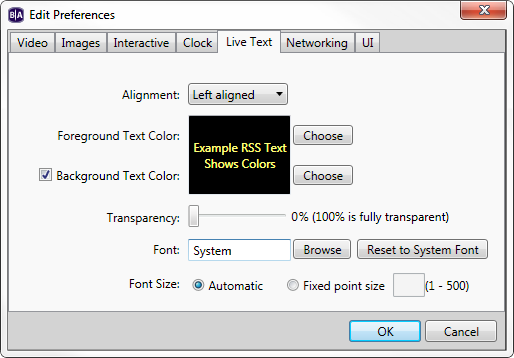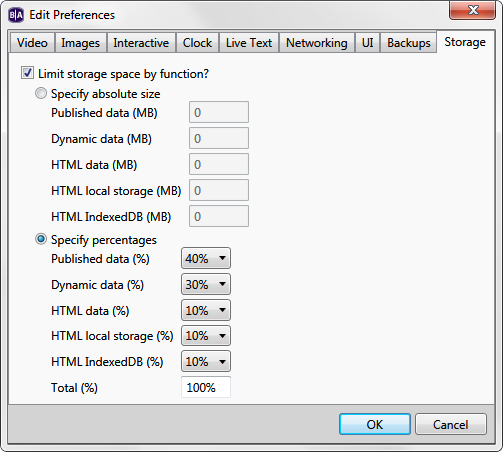4.6-Editing Preferences
ON THIS PAGE
Whenever you create a new project, various presentation properties will be set using the default settings. If you often use the same set of properties, you can save time by changing the default settings to what you use most often. To edit default settings, navigate to Edit > Preferences on the menu bar.
Changing default settings in the Video, Images, Interactive, Clock, and Live Text tabs does not adjust values in the current project. The Networking, UI, Backups, and Storage tabs are related to other aspects of the publishing process, and will therefore apply to the current presentation as well.
Video
The Video tab allows you to specify default settings for video states.
- Volume: Specify a default value between 0 and 100.
- Live video – time on screen: Set a default period for live videos to remain on screen (in seconds).
Images
The Images tab allows you to specify default settings for image states.
- Slide transition: Use the dropdown list to set an effect for image transitions.
- Slide delay interval: Set how long each image displays (in seconds).
Interactive
Use the Interactive tab to set a default timeout period for media files (in seconds).
Clock
Use the dropdown list to link the date and time format to a language. This option affects the date/time display in Clock zones. To customize the format, click Customize to open the Clock Localization window.
- Date: Use the Edit field to customize the date format on the player (refer to the chart of terms for different abbreviation styles). Use the Preview date button to see an example of how the date format will look. You can also customize how months and days are displayed in both Short and Long form.
- Time: Use the Edit field to customize how time is displayed on the player (refer to the chart of terms for different measurements). Use the Preview time button to see an example of how the time format will look. You can also customize how the AM and PM abbreviations are formatted.
Note
A BrightSign Network account can only have one date/time format setting: Changing the date/time format for one presentation, and then uploading it to the BrightSign Network, will change the date/time format for all presentations on your account. Similarly, a standalone player can only have one date/time format, even if there are multiple presentations scheduled on the player.
Live Text
Use the Live Text tab to edit default preferences for text fields in Live Text states:
- Alignment: Use the dropdown list to set whether the text is left aligned, right aligned, or centered.
- Foreground text color: Click Choose to select a color for the text.
- Background text color: Check this box to include a background color for text fields. Click Choose and set a default color for the backgrounds.
- Transparency: Drag the bar to set the transparency for the background text color.
Note
Transparency does not appear in the Live Text image preview or in Presentation Preview. You will need to publish the presentation to a BrightSign player to view the level of transparency.
- Font: Click Browse to locate and select a font for the text. You can use any TrueType font. Click Reset to System Font to reset the font to the default.
- Font size: Select Automatic to fit the text to the height of the text field, or select Fixed point size to enter a value for the font size (1 - 500).
Networking
The Networking tab allows you to enable and disable networking options in BrightAuthor.
- Enable BrightSign Network: Check this box to enable BSN features in the Create, Publish and Manage tabs, as well as the BrightSign Unit Setup window.
- Enable BrightSign Local Networking: Check this box to enable Local File Networking (LFN) options in the Publish and Manage tabs, well as the BrightSign Unit Setup window..
- Enable Bonjour: Check this box to enable Bonjour. BrightAuthor uses Bonjour to detect LFN players on the local network; if Bonjour is disabled, you will need to enter the IP address of each LFN player manually to publish to it and manage it. See this FAQ to learn more about installing Bonjour for Windows.
- Enable Simple File Networking: Check this box to enable Simple File Networking (SFN) options in the Publish tab and BrightSign Unit Setup window.
- Use Proxy Server: Check this box if BrightAuthor needs to communicate through a proxy server to reach the Internet. Enter the Address and Port of the proxy server. If the proxy server requires authentication, you will be prompted to enter login credentials. If the proxy uses a Windows domain for authentication, you will also need to specify a domain name.
UI
The UI tab allows you to edit various options related to the BrightAuthor playlist UI.
Content
- Show Image File Resize dialog?: Displays a dialog box whenever you add an image that is larger than the maximum image size allowed by the player model. It will give you the option to either cancel the action or create a downscaled copy of the image to use in the playlist.
- Resize image files for BrightSign: Automatically creates a downscaled copy whenever the original size of the added image is too large.
Publishing
- Show file overwrite dialog?: Displays a dialog box asking whether you want to overwrite preexisting files when publishing a presentation.
- Copy and replace duplicate files when publishing locally?: Overwrites media files with the same name when publishing locally.
- Show Save Schedule dialog?: Displays a dialog box when you exit the Publish tab, asking if you would like to save the schedule as a separate file. You can then use this schedule file with any presentation by navigating to Schedule > Open while in the Publish tab.
- Show read/write file system warnings dialog?: Displays a warning whenever you attempt to publish to a file system that is not fully supported.
- Show read only file system warnings dialog?: Displays a warning whenever you attempt to publish to a file system that does not allow file writes on the BrightSign player. Player logs and network updates are not supported on read-only file systems.
Save Properties
- Show Save Properties dialog: Displays a dialog box whenever you exit the Presentation Properties window having made changes to the settings. The dialog box will ask you whether you want to apply the new settings to the current presentation or to all future presentations in addition to current presentation.
Content Update Password Cleared Warning
- Show Content Update Password Cleared Warning dialog: Displays a dialog box whenever you publish a content update that will clear the Content Update Password.
Transitions
- Display Mode: Determine how BrightAuthor draws event connections between states in the interactive playlist area:
- Automatic: Displays either a line or a label, depending on the current playlist layout.
- Always display line: Displays event lines between states.
- Always display label: Displays numbered event labels that show connections between states.
- Label Location: Determine where numbered event labels are located:
- Bottom: Numbered event labels are located below states.
- Right: Numbered event labels are located to the right of states.
New BrightSign Presentation Initial Folder
This option refers to the Where save destination folder in the New Project window. Select one of the following:
- Last Folder Used: The destination defaults to the last folder used to save a presentation project.
- My Documents: The destination defaults to the My Documents folder.
Backups
The Backups tab allows you to configure automated backup saves for projects (in case BrightAuthor closes without saving the presentation project).
- Automatically backup BrightAuthor presentation files: Check this box to enable automated saving of BrightAuthor presentation files. Specify how often you want backup saves to occur.
- Backup a maximum of this number of backups: Specify how many backup copies of a single presentation can exist. Once this limit is reached, BrightAuthor will begin overwriting backup copies, beginning with the oldest file.
Storage
Checking the Limit storage space by function box allows you to divide the presentation storage device (SD card, USB drive, etc.) into different segments. You can then allot maximum sizes to those segments to ensure that a certain type of data does not take up too much space on the storage device.
Note that, if you select Specify absolute size, it is possible to specify a combined set of segments that is larger or smaller than the absolute size of your storage device. If you select Specify percentages, you will need to ensure that the percentages add up to 100% (which is equivalent to the absolute size of the storage device).
The segment types are specified as follows:
- Published data: The maximum size allotted to all presentation and content files that are written to the storage device during the publish process. This includes audio, video, images, text, and HTML content files.
- Dynamic data: The maximum size of all dynamic content, including Dynamic Playlists and MRSS feeds. When this segment runs out of space, dynamic content files will be deleted to create space, starting with the oldest files first.
- HTML data: The maximum size of the HTML application cache.
- HTML local storage: The maximum size of all JavaScript variables and data.
- HTML IndexedDB: The maximum amount of storage allocated to the IndexedDB web database application.

